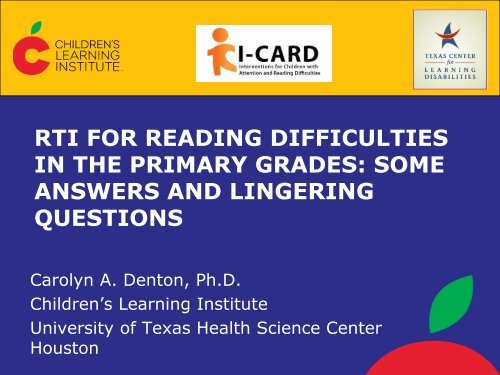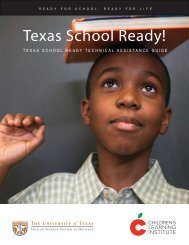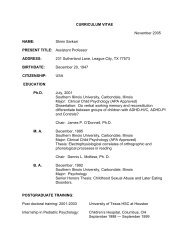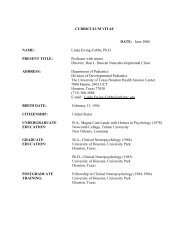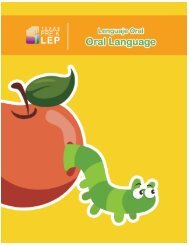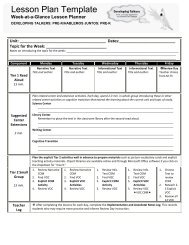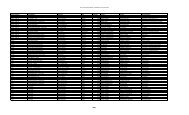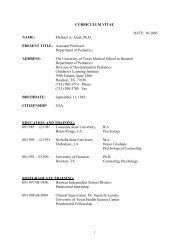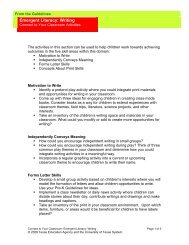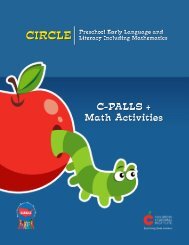rti for reading difficulties in the primary grades - Children's Learning ...
rti for reading difficulties in the primary grades - Children's Learning ...
rti for reading difficulties in the primary grades - Children's Learning ...
- No tags were found...
Create successful ePaper yourself
Turn your PDF publications into a flip-book with our unique Google optimized e-Paper software.
RTI FOR READING DIFFICULTIESIN THE PRIMARY GRADES: SOMEANSWERS AND LINGERINGQUESTIONSCarolyn A. Denton, Ph.D.Children’s Learn<strong>in</strong>g InstituteUniversity of Texas Health Science CenterHouston
Objectives• Describe <strong>the</strong> characteristics of and currentresearch base on <strong>the</strong> RTI framework <strong>in</strong> <strong>primary</strong>grade<strong>read<strong>in</strong>g</strong>.– What is RTI <strong>in</strong> early <strong>read<strong>in</strong>g</strong>?– What is evidence-based <strong>in</strong>struction?– How should RTI <strong>in</strong> early <strong>read<strong>in</strong>g</strong> beimplemented?– How should <strong>in</strong>tervention responsiveness bedeterm<strong>in</strong>ed?• Identify questions that have yet to be adequatelyaddressed by researchers.
RTI <strong>in</strong> Early Read<strong>in</strong>gComprehensive school-wideframeworks through whichstudents at-risk <strong>for</strong> <strong>read<strong>in</strong>g</strong><strong>difficulties</strong> are identified andprovided with evidence-based anddata-<strong>in</strong><strong>for</strong>med <strong>in</strong>struction and<strong>in</strong>terventions be<strong>for</strong>e <strong>the</strong>y fallfar<strong>the</strong>r beh<strong>in</strong>d <strong>the</strong>ir peers.
Clos<strong>in</strong>g <strong>the</strong> GapStudents who struggle with<strong>read<strong>in</strong>g</strong> <strong>in</strong> <strong>the</strong> early <strong>grades</strong> arelikely to cont<strong>in</strong>ue to struggle if<strong>the</strong>y receive only typical<strong>in</strong>struction.Francis, Shaywitz, Stueb<strong>in</strong>g, Shaywitz, & Fletcher,1996; Jewel, 1988; Torgesen & Burgess, 1998
Clos<strong>in</strong>g <strong>the</strong> Gap―An underly<strong>in</strong>g assumption of RTIis that <strong>the</strong>re is a w<strong>in</strong>dow ofopportunity where<strong>in</strong> <strong>read<strong>in</strong>g</strong>difficulty is more easily altered by<strong>in</strong>struction and risk of later <strong>read<strong>in</strong>g</strong>difficulty is likewise m<strong>in</strong>imized.‖Simmons et al. (2008), p. 159
A Prevention SystemThe implementation of a comprehensiveRTI model ―may reduce <strong>the</strong> number ofstudents referred <strong>for</strong> special education,promote effective early <strong>in</strong>tervention,provide diagnostic <strong>in</strong><strong>for</strong>mation to consider<strong>in</strong> <strong>the</strong> identification of a disability, and/ormay reduce <strong>the</strong> impact of a disability on achild’s academic progress‖Council <strong>for</strong> Exceptional Children (2007), p. 2
Essential Characteristics• Multi-tiered <strong>in</strong>tervention systems• Evidence-based classroom <strong>read<strong>in</strong>g</strong> <strong>in</strong>struction• Supplemental <strong>in</strong>tervention provided when needed• Student progress is monitored and outcomesevaluated.• Student assessment data are exam<strong>in</strong>ed regularly,and decisions related to <strong>in</strong>tervention are based onstudent data.• Sufficient teacher professional development isprovided so that high-quality <strong>in</strong>struction isdelivered with fidelity to evidence-based programsand practices.Gersten et al., 2008; Kovaleski & Black, 2010
3 Tiers• Tier 1 <strong>in</strong>tervention (<strong>primary</strong> prevention): qualityevidence-based, differentiated classroom<strong>read<strong>in</strong>g</strong> <strong>in</strong>struction and universal screen<strong>in</strong>g toidentify students at-risk <strong>for</strong> <strong>read<strong>in</strong>g</strong> <strong>difficulties</strong>• Tier 2 <strong>in</strong>tervention (secondary <strong>in</strong>tervention orsecondary prevention): supplemental<strong>in</strong>tervention provided to students identified asat-risk <strong>for</strong> <strong>read<strong>in</strong>g</strong> <strong>difficulties</strong>• Tier 3 <strong>in</strong>tervention (te<strong>rti</strong>ary <strong>in</strong>tervention orte<strong>rti</strong>ary prevention): higher <strong>in</strong>tensity<strong>in</strong>tervention <strong>for</strong> students with <strong>in</strong>adequateresponse <strong>in</strong> Tier 2
Evidence-Based Instruction• Characteristics related to improvedoutcomes <strong>for</strong> students with <strong>read<strong>in</strong>g</strong><strong>difficulties</strong>• Common characteristics of effective<strong>in</strong>terventions
Evidence-Based Instruction• Instruction that is purposeful and targetedat important objectives, progress<strong>in</strong>glogically from easier to more challeng<strong>in</strong>gskills• Explicit <strong>in</strong>struction, <strong>in</strong> which skills andstrategies are clearly modeled and keyconcepts are directly taught• Extended opportunities <strong>for</strong> guided and<strong>in</strong>dependent practice with both correctiveand positive feedback, <strong>in</strong>clud<strong>in</strong>gcumulative practice
Evidence-Based Instruction• Engaged practice <strong>in</strong> <strong>read<strong>in</strong>g</strong> andrespond<strong>in</strong>g to connected text with andwithout teacher support and feedback• Instructional <strong>for</strong>mats that promote activestudent <strong>in</strong>volvement and provide manyopportunities to respond• Data-based decision-mak<strong>in</strong>g: based ondiagnostic assessments; mastery of keyskills and strategies is monitored;reteach<strong>in</strong>g is provided when needed
Select<strong>in</strong>g a Program• High-quality implementation of a researchvalidatedor evidence-based <strong>in</strong>structional program• Research-validated: The program itself has beenevaluated <strong>in</strong> quality research and found to havepositive outcomes <strong>for</strong> students with <strong>read<strong>in</strong>g</strong><strong>difficulties</strong> (<strong>in</strong> more than one study, with studentssimilar to yours)• Evidence-based: Look <strong>for</strong> <strong>the</strong> characteristics listedon <strong>the</strong> last 2 slides, <strong>in</strong>clud<strong>in</strong>g mastery tests; Tier 1Core programs usually need to be adapted byadd<strong>in</strong>g additional practice and more explicit<strong>in</strong>struction <strong>for</strong> at-risk readers.
Tier 1• Quality, Evidence-Based Instruction: Mostchildren will learn to read adequately• Differentiated Instruction: based on diagnosticand progress monitor<strong>in</strong>g assessments (Teachwhat <strong>the</strong> student needs to learn: not too easy, nottoo hard)• Universal screen<strong>in</strong>g and progress monitor<strong>in</strong>g• Teacher professional development
Tiers 2 and 3• Converg<strong>in</strong>g evidence supports <strong>the</strong>effectiveness of <strong>in</strong>structional <strong>read<strong>in</strong>g</strong><strong>in</strong>terventions provided with sufficientfidelity and <strong>in</strong>tensity to <strong>primary</strong>-<strong>grades</strong>tudents at-risk <strong>for</strong> <strong>read<strong>in</strong>g</strong> <strong>difficulties</strong>• Most studies were conducted with 1:1 orsmall-group standard protocol<strong>in</strong>terventions, primarily <strong>in</strong> pull-out <strong>for</strong>mats.(Research Syn<strong>the</strong>ses and Meta-Analyses: Benner, Nelson, Ralston,& Mooney, 2010; Cavanaugh, Kim, Wanzek, & Vaughn, 2004; Ehri,Nunes, Stahl, & Willows, 2001; Elbaum, Vaughn, Hughes, & Moody,2000; Torgesen, 2004; Wanzek & Vaughn, 2007).
Studies of Multi-TieredIntervention Frameworks• Some studies have evaluated outcomesacross two or more tiers of <strong>read<strong>in</strong>g</strong><strong>in</strong>tervention• Generally report positive effects on<strong>read<strong>in</strong>g</strong> outcomes and a reduction <strong>in</strong><strong>the</strong> percentages of children who rema<strong>in</strong>at-risk <strong>for</strong> <strong>read<strong>in</strong>g</strong> <strong>difficulties</strong>.
Studies at Tier 3• Several studies have exam<strong>in</strong>ed <strong>in</strong>tervention <strong>for</strong>students with severe <strong>read<strong>in</strong>g</strong> <strong>difficulties</strong>• F<strong>in</strong>d<strong>in</strong>gs: It is possible to <strong>in</strong>tervene successfully,but <strong>in</strong>dividual responsiveness varies• Few studies have exam<strong>in</strong>ed effects of Tier 3 <strong>for</strong>students with <strong>in</strong>adequate responsiveness <strong>in</strong>Tiers 1 and 2• These are <strong>the</strong> students who would likely beserved <strong>in</strong> special education <strong>in</strong> an RTI modelNeed <strong>for</strong> Research
Implementation of Tiers 2 and 3Schools have limited time, personnel, andfund<strong>in</strong>g.• Who can provide <strong>in</strong>tervention? Where should<strong>in</strong>tervention be provided?• What is <strong>the</strong> optimum group size?• When should Tier 2 beg<strong>in</strong>?• How should <strong>in</strong>tervention be scheduled and howlong should it be provided?• How should responsiveness be determ<strong>in</strong>ed?
Interventionists at Tier 2• In research, effective <strong>in</strong>terventions are most oftenprovided by <strong>read<strong>in</strong>g</strong> <strong>in</strong>terventionists o<strong>the</strong>r than <strong>the</strong>classroom teacherIntervention can be successfully provided by:• Read<strong>in</strong>g specialists or o<strong>the</strong>r ce<strong>rti</strong>fied teachers―pull-out‖ or ―push-<strong>in</strong>‖• Paraprofessionals who receive tra<strong>in</strong><strong>in</strong>g andsusta<strong>in</strong>ed coach<strong>in</strong>g from an experienced teacher.• Classroom teachers who provide focused, targeted<strong>in</strong>tervention regularly and with high fidelity.• But what is <strong>the</strong> BEST way? There is need <strong>for</strong>experimental research contrast<strong>in</strong>g <strong>in</strong>terventionists.
Classroom Teachers asInterventionists at Tier 2• General education classroom teachers who providesmall-group <strong>in</strong>struction with<strong>in</strong> <strong>the</strong>ir own classroomswith sufficient <strong>in</strong>tensity and fidelity• Susta<strong>in</strong>ed professional development <strong>in</strong>implementation of <strong>the</strong> <strong>in</strong>tervention and <strong>in</strong>classroom management skills to allow <strong>the</strong>teacher to provide focused, consistent<strong>in</strong>tervention to small groups while ensur<strong>in</strong>g thato<strong>the</strong>r students <strong>in</strong> <strong>the</strong> class are actively <strong>in</strong>volved<strong>in</strong> purposeful <strong>in</strong>dependent practice activities• Recommend a suppo<strong>rti</strong>ve, structured publishedprogram
Paraprofessionals at Tier 2• Well-prepared and well-supported paraprofessionalshave provided Tier 2 successfully <strong>in</strong>research under certa<strong>in</strong> conditions:– <strong>in</strong>terventionists are carefully selected– group sizes are kept very small or 1:1– highly structured <strong>read<strong>in</strong>g</strong> <strong>in</strong>tervention programsare used– an experienced teacher tra<strong>in</strong>s and coaches <strong>the</strong>paraprofessionals, spend<strong>in</strong>g extendedamounts of time with <strong>the</strong>m(Grek, Ma<strong>the</strong>s, & Torgesen, 2003; Vadasy, Sanders, &Peyton, 2006; Vadasy, Sanders, & Tudor, 2007).
Interventionists at Tier 3• Well-qualified teachers who are provided withprofessional development <strong>in</strong> <strong>the</strong> <strong>in</strong>terventionprogram and <strong>in</strong> teach<strong>in</strong>g students with persistent<strong>read<strong>in</strong>g</strong> <strong>difficulties</strong>• Students <strong>in</strong> Tier 3 tend to have– relatively severe problems <strong>in</strong> phonologicalprocess<strong>in</strong>g, process<strong>in</strong>g speed, and work<strong>in</strong>gmemory– challeng<strong>in</strong>g behaviors and attention deficits• Difficult-to-teach students place large demands onteachers’ knowledge and skills• Probably best to provide Tier 3 <strong>in</strong> a quiet locationoutside of <strong>the</strong> regular classroom
Group Size• Small enough to promote maximum activestudent <strong>in</strong>volvement and allow <strong>the</strong> teacher tomonitor and respond appropriately to eachstudent.• 1:1 has positive outcomes (Elbaum, Vaughn,Hughes, & Moody, 2000)• For students <strong>in</strong> k<strong>in</strong>dergarten through Grade 3,higher effects are found <strong>in</strong> studies with 1:1<strong>in</strong>struction or very small groups than with largergroups (Wanzek and Vaughn, 2007)• Tier 2-type <strong>in</strong>terventions: 1:2 or 1:3 generally aseffective as 1:1 (Iversen, Tunmer, & Chapman,2005; Vaughn et al., 2003).
Group Size at Tier 3• Some students who receive Tier 3 <strong>in</strong>terventionmay require 1:1 <strong>in</strong>struction• There are examples <strong>in</strong> research of effectiveTier 3 <strong>in</strong>terventions provided <strong>in</strong> very smallgroups (1:2 or 1:3).• Probably best decided on an <strong>in</strong>dividual basisby RTI problem-solv<strong>in</strong>g teams based on data<strong>in</strong>dicat<strong>in</strong>g <strong>the</strong> student’s needs <strong>in</strong> <strong>read<strong>in</strong>g</strong>,attention, and behavior.
When to Beg<strong>in</strong> Tier 2?• Researchers have tested models that beg<strong>in</strong> Tier2 <strong>in</strong> k<strong>in</strong>dergarten (e.g., O’Connor et al., 2005),fall of first grade (e.g., Ma<strong>the</strong>s et al., 2005), andw<strong>in</strong>ter of first grade (e.g., Denton et al., <strong>in</strong>press)• K<strong>in</strong>dergarten may be a ―w<strong>in</strong>dow of opportunity‖(Coyne et al., 2004; Simmons et al., 2008) butit can be hard to accurately identify k<strong>in</strong>dergartenstudents who need supplemental <strong>in</strong>tervention(Jenk<strong>in</strong>s, Hudson, & Johnson, 2007).Need <strong>for</strong> Research
When to Beg<strong>in</strong> Tier 2:The Trade-OffPotentialbenefits ofvery early<strong>in</strong>terventionIntervention maybe provided tosome studentswho don’t need it.Evaluate priorities and resources: Theanswer may differ <strong>for</strong> different children.
When to Beg<strong>in</strong> Tier 2?• Two-stage screen<strong>in</strong>g process may improveaccuracy <strong>in</strong> identify<strong>in</strong>g at-risk readers (Comptonet al., 2010)– Screen at beg<strong>in</strong>n<strong>in</strong>g of first grade– Monitor progress <strong>for</strong> five weeks to elim<strong>in</strong>ate―false positives‖.• But: This would delay <strong>the</strong> onset of <strong>in</strong>tervention <strong>for</strong>all students.
When to Beg<strong>in</strong> Tier 2?• It may make sense to provide immediate<strong>in</strong>tervention to <strong>the</strong> most impaired readers <strong>in</strong> k-1and monitor <strong>the</strong> progress of less impairedstudents• Screen all students• If needed, adm<strong>in</strong>ister additional assessments tothose who per<strong>for</strong>m lowest on <strong>the</strong> screen (e.g.,norm-referenced phonemic awareness or word<strong>read<strong>in</strong>g</strong>test)• Decisions made by <strong>the</strong> problem-solv<strong>in</strong>g teambased on student assessment outcomes
Schedule and Duration of Tier 2• What Works Clear<strong>in</strong>ghouse: 3-5 times perweek <strong>for</strong> 20 to 40 m<strong>in</strong>utes ―<strong>for</strong> a reasonableamount of time be<strong>for</strong>e provid<strong>in</strong>g a more<strong>in</strong>tensive daily Tier 3 <strong>in</strong>tervention‖ (Gersten etal., 2008, p. 26).• Syn<strong>the</strong>sis of <strong>read<strong>in</strong>g</strong> <strong>in</strong>tervention studiesshowed that provid<strong>in</strong>g <strong>in</strong>tervention <strong>for</strong> at least20 weeks is feasible and students with <strong>read<strong>in</strong>g</strong><strong>difficulties</strong> and disabilities benefit (Wanzek andVaughn, 2007)
Schedule and Duration of Tier 2• Few experimental studies have directly exam<strong>in</strong>ed<strong>the</strong> question, and results have been mixed.• Some found that students who received <strong>the</strong> same<strong>in</strong>tervention more times per week did better thanthose who received it less often (e.g., Al Otaiba etal., 2005; k<strong>in</strong>dergarten).• Some found that this made little or no difference<strong>in</strong> outcomes (e.g., Denton et al., <strong>in</strong> press; grade1).• More studies needed.
Schedule and Duration of Tier 2• Denton et al.: many children failed to close <strong>the</strong>gap <strong>in</strong> brief small-group <strong>in</strong>terventions (16-32hours)• Fuchs, Compton, Fuchs, Bryant, and Davis(2008):1st graders who received a 9-week<strong>in</strong>tervention, 45 m<strong>in</strong>, 4 X per week (about 27hours), outper<strong>for</strong>med control students onprogress monitor<strong>in</strong>g measures and somestandardized <strong>read<strong>in</strong>g</strong> tests.• Students who are more impaired generallyrequire more time to close <strong>the</strong> gap (Vaughn,L<strong>in</strong>an-Thompson, & Hickman, 2003; Grade 2 : 10weeks, 20 weeks, 30 weeks, never)
Schedule and Duration of Tier 2• More times per week with fewer weeks orfewer times per week with more weeks?• Massed vs. distributed practice researchsuggests that distributed lessons arebetter• Denton et al. (<strong>in</strong> press) found nodifference between 4 X per week <strong>for</strong> 8weeks and 2 X per week <strong>for</strong> 16 weeks.
Schedul<strong>in</strong>g and Duration at Tier 3• What Works Clear<strong>in</strong>ghouse (Gersten et al.,2008): Tier 3 <strong>read<strong>in</strong>g</strong> <strong>in</strong>tervention should be<strong>in</strong>dividualized, ―concentrated <strong>in</strong>struction‖delivered <strong>in</strong> ―multiple and extended<strong>in</strong>structional sessions daily‖ (p. 10).• Number of weeks—or months—<strong>in</strong> Tier 3 willdepend on <strong>the</strong> needs of <strong>the</strong> students and <strong>the</strong>level of <strong>in</strong>tensity with which <strong>in</strong>tervention isdelivered.• Monitor<strong>in</strong>g by <strong>the</strong> Problem Solv<strong>in</strong>g Teamrecommended (student data).
Increas<strong>in</strong>g <strong>the</strong> Intensityof an Intervention• Smaller groups or 1:1• Longer sessions or multiple sessionsacross <strong>the</strong> day• Extended duration (20-30 weeks, ormore)• Increased:– Opportunities to respond– Teacher-student <strong>in</strong>teractions– Active student <strong>in</strong>volvement
Determ<strong>in</strong><strong>in</strong>g Adequate andInadequate ResponsivenessApproaches differ across four dimensions.What isMeasuredDoma<strong>in</strong> ofRead<strong>in</strong>gWhat iscomparedThe goalRate of growth, f<strong>in</strong>al outcomes, or bothPA, Word <strong>read<strong>in</strong>g</strong>, fluency,comprehensionAt-risk students’ scores compareddirectly to pre-established benchmarks orto scores of o<strong>the</strong>r groups of students(e.g., national norms, classmates)The specific score cut-po<strong>in</strong>ts orbenchmarks appliedFuchs et al., 2008
Determ<strong>in</strong><strong>in</strong>g Adequate andInadequate Responsiveness• Approaches that differ on <strong>the</strong>se dimensionsare likely to identify different students asadequate and <strong>in</strong>adequate responders• There may be little or no overlap <strong>in</strong> <strong>the</strong>identified groups (Barth et al., 2008; Fuchset al., 2008)
What is measured? What k<strong>in</strong>d ofassessment is used?• Progress monitor<strong>in</strong>g assessments: Is <strong>the</strong>student mak<strong>in</strong>g adequate progress toward<strong>in</strong>structional goals? Is he/she ―on track‖ tomeet benchmarks? What is <strong>the</strong> student’s rateof growth?• Most use Curriculum-Based Measures (CBMs)closely aligned with <strong>in</strong>structional content(phonemic awareness, letter knowledge, word<strong>read<strong>in</strong>g</strong>, phonemic decod<strong>in</strong>g, word <strong>read<strong>in</strong>g</strong>fluency, oral <strong>read<strong>in</strong>g</strong> fluency <strong>in</strong> connectedtext)
Progress Monitor<strong>in</strong>g andDiagnostic Assessment• CBMs may be published tests, usually withtimed adm<strong>in</strong>istration (e.g., DIBELS)• May be mastery tests that coord<strong>in</strong>ate with apublished program or teacher-developed<strong>in</strong><strong>for</strong>mal assessments of mastery of taughtskills and concepts (e.g., letter-sound<strong>in</strong>ventories, sight word <strong>in</strong>ventories, unitmastery tests)• CBMs can provide diagnostic <strong>in</strong><strong>for</strong>mation to<strong>in</strong><strong>for</strong>m targeted <strong>in</strong>struction
What is measured? What k<strong>in</strong>d ofassessment is used?• Outcome assessments evaluatewhe<strong>the</strong>r goals are atta<strong>in</strong>ed (f<strong>in</strong>aloutcomes)• Often standardized tests• Norm-referenced tests (tests thatprovide standard scores such aspercentiles) can tell whe<strong>the</strong>r <strong>the</strong>gap has been closed
What is measured? What k<strong>in</strong>d ofassessment is used?What is <strong>the</strong> goal?– At-risk students make acceleratedgrowth?– At-risk students read ―on gradelevel‖?– At-risk students close <strong>the</strong> gap withaverage students?
Doma<strong>in</strong> of Read<strong>in</strong>g Measured• Rate of responsiveness is usually lowerwith fluency criteria than with word <strong>read<strong>in</strong>g</strong>criteria.• At <strong>the</strong> end of Grade 1, students with poorresponse to <strong>in</strong>tervention <strong>in</strong> both decod<strong>in</strong>gand fluency were more impaired overall <strong>in</strong>cognitive doma<strong>in</strong>s (phonemic awareness,work<strong>in</strong>g memory, etc.) than those withdeficits <strong>in</strong> fluency alone. (Fletcher et al.,2010)
Doma<strong>in</strong> of Read<strong>in</strong>g MeasuredWhat outcomes are important? Whatconstitutes ―<strong>read<strong>in</strong>g</strong> on grade level‖?– Especially at early stages of <strong>read<strong>in</strong>g</strong>development, accurate and fluent word <strong>read<strong>in</strong>g</strong>is critical.– Word <strong>read<strong>in</strong>g</strong> ability cont<strong>in</strong>ues to developacross <strong>grades</strong> k-3, and many older poorreaders have impaired word <strong>read<strong>in</strong>g</strong>.– Oral <strong>read<strong>in</strong>g</strong> fluency <strong>in</strong> connected text is highlypredictive of comprehension <strong>in</strong> <strong>grades</strong> 1-3.– Read<strong>in</strong>g comprehension is <strong>the</strong> ultimate goal.
What is Compared?• Compare scores of at-risk readers to predeterm<strong>in</strong>edbenchmarks (50 correct wordsper m<strong>in</strong>ute <strong>in</strong> oral <strong>read<strong>in</strong>g</strong> fluency at <strong>the</strong>end of Grade 1)• Compare scores of at-risk readers to thoseof o<strong>the</strong>r students us<strong>in</strong>g national norms(below <strong>the</strong> 25 th percentile)• Compare scores of at-risk readers to thoseof average readers <strong>in</strong> <strong>the</strong> same school orclassroom (1 standard deviation below <strong>the</strong>classroom mean)
What Score or Benchmark isApplied• Every test conta<strong>in</strong>s error—some morethan o<strong>the</strong>rs (reliability).• The use of a s<strong>in</strong>gle test or benchmark todeterm<strong>in</strong>e responsiveness is problematic(Barth et al., 2008)• When you apply a s<strong>in</strong>gle ―cut-po<strong>in</strong>t‖ to agroup of scores, <strong>the</strong>re will be <strong>in</strong>accuraciesbecause scores near <strong>the</strong> cut-po<strong>in</strong>t willfluctuate above and below <strong>the</strong> l<strong>in</strong>e withrepeated test<strong>in</strong>g.
Multiple Indicators• Use confidence <strong>in</strong>tervals (a range ofscores ra<strong>the</strong>r than a s<strong>in</strong>gle score) andmultiple criteria, especially when RTI dataare used to help determ<strong>in</strong>e whe<strong>the</strong>r achild has a learn<strong>in</strong>g disability.• Cont<strong>in</strong>ue to monitor students who exitTier 2/3 and provide ―booster‖ sessionsor return <strong>the</strong>m to <strong>in</strong>tervention if needed.
RTI Research <strong>in</strong> EarlyRead<strong>in</strong>gWe would like quick clear-cut answers but…• Scientific evidence grows <strong>in</strong>crementally ove<strong>rti</strong>me• S<strong>in</strong>gle studies rarely result <strong>in</strong> clear-cut―answers‖• It is <strong>the</strong> convergence of f<strong>in</strong>d<strong>in</strong>gs fromdifferent studies that best <strong>in</strong><strong>for</strong>ms practice.
RTI Research <strong>in</strong> Early Read<strong>in</strong>gAreas with a convergence of f<strong>in</strong>d<strong>in</strong>gs:1. Characteristics of evidence-based<strong>in</strong>struction <strong>for</strong> students with <strong>read<strong>in</strong>g</strong><strong>difficulties</strong>2. Effectiveness of early <strong>read<strong>in</strong>g</strong><strong>in</strong>tervention3. If we do noth<strong>in</strong>g, students rarelyimprove on <strong>the</strong>ir own.
Areas <strong>in</strong> Need of MoreResearch1. The conditions under which early <strong>read<strong>in</strong>g</strong><strong>in</strong>terventions are most effective <strong>in</strong> RTI contexts(<strong>in</strong>terventionists, duration, etc.)2. Effective <strong>read<strong>in</strong>g</strong> <strong>in</strong>struction <strong>for</strong> students whomake limited progress <strong>in</strong> Tier 3 <strong>in</strong>tensive<strong>in</strong>terventions3. Long-range effects of different approaches todeterm<strong>in</strong><strong>in</strong>g <strong>in</strong>tervention responsiveness4. The effects of fully implemented RTI frameworks.5. Effective <strong>in</strong>terventions <strong>for</strong> children with <strong>read<strong>in</strong>g</strong><strong>difficulties</strong> plus o<strong>the</strong>r k<strong>in</strong>ds of <strong>difficulties</strong> (e.g.,ADHD; I-CARD study <strong>in</strong> progress! Stay tuned.)Denton, <strong>in</strong> press
The Bottom L<strong>in</strong>e―I wish my teacher would help melearn to read. Sit down and read withme...I’d learn to read <strong>the</strong>n.‖…Middle School Student <strong>in</strong>McCray, Vaughn, & Neal, 2001
This presentation was supported <strong>in</strong> part bygrants P50 HD052117 and R01 HD060617-01 from <strong>the</strong> Eunice Kennedy ShriverNational Institute of Child Health andHuman Development (NICHD). Thecontent is solely <strong>the</strong> responsibility of <strong>the</strong>authors and does not necessarilyrepresent <strong>the</strong> official views of <strong>the</strong> NICHDor <strong>the</strong> National Institutes of Health.
Carolyn A. Denton, Ph.D.Department of PediatricsChildren’s Learn<strong>in</strong>g InstituteUniversity of Texas Health Science Center HoustonCarolyn.A.Denton@uth.tmc.eduA copy of this presentation will be posted at:http://www.childrenslearn<strong>in</strong>g<strong>in</strong>stitute.org/LibraryAndwww.texasldcenter.org
1RTI FOR Read<strong>in</strong>g Difficulties <strong>in</strong> <strong>the</strong> Primary Grades: Some Answers and L<strong>in</strong>ger<strong>in</strong>gQuestionsCarolyn A. Denton, Ph.D.Children’s Learn<strong>in</strong>g Institute, University of Texas Health Science Center HoustonCouncil <strong>for</strong> Exceptional Children, April 27, 2011, National Harbor, MDReferencesAl Otaiba, S., Schatschneider, C., & Silverman, E. (2005). Tutor-assisted <strong>in</strong>tensive learn<strong>in</strong>gstrategies <strong>in</strong> k<strong>in</strong>dergarten: How much is enough? Exceptionality, 13(4), 195-208.Al Otaiba, S., & Torgesen, J. (2007). Effects from <strong>in</strong>tensive standardized k<strong>in</strong>dergarten and firstgrade<strong>in</strong>terventions <strong>for</strong> <strong>the</strong> prevention of <strong>read<strong>in</strong>g</strong> <strong>difficulties</strong>. In S.R. Jimerson, M.K. Burns, &A.M. VanDerHeyden (Eds.). Handbook of response to <strong>in</strong>tervention (pp. 212-222). NY: Spr<strong>in</strong>ger.Barth, A. E., Stueb<strong>in</strong>g, K. K., Anthony, J. L., Denton, C. A, Ma<strong>the</strong>s, P. G., Fletcher, J. M., &Francis, D. J. (2008). Agreement among response to <strong>in</strong>tervention criteria <strong>for</strong> identify<strong>in</strong>gresponder status. Learn<strong>in</strong>g and Individual Differences, 18, 296-307.Benner, G. J., Nelson, J. R., Ralston, N. C., Mooney, P. (2010). A meta-analysis of <strong>the</strong> effects of<strong>read<strong>in</strong>g</strong> <strong>in</strong>struction on <strong>the</strong> <strong>read<strong>in</strong>g</strong> skills of students with or at risk of behavioral disorders.Behavioral Disorders, 25(2), 86-102.Blachman, B. A., Schatschneider, C., Fletcher, J. M., Francis, D. J., Clonan, S., Shaywitz, B., &Shaywitz, S. (2004). Effects of <strong>in</strong>tensive <strong>read<strong>in</strong>g</strong> remediation <strong>for</strong> second and third graders.Journal of Educational Psychology, 96, 444- 461.Cavanaugh, C. L., Kim, A.-H., Wanzek, J., Vaughn, S. (2004). K<strong>in</strong>dergarten <strong>read<strong>in</strong>g</strong><strong>in</strong>terventions <strong>for</strong> at-risk students: Twenty years of research. Learn<strong>in</strong>g Disabilities: AContemporary Journal, 2(1), 9-21.Chard, D. J., Vaughn, S., Tyler, B. J. (2002). A syn<strong>the</strong>sis of research on effective <strong>in</strong>terventions<strong>for</strong> build<strong>in</strong>g <strong>read<strong>in</strong>g</strong> fluency with elementary students with learn<strong>in</strong>g disabilities. Journal ofLearn<strong>in</strong>g Disabilities, 35(5), 386-406.Compton, D.L., Fuchs, D., Fuchs, L.S., Bouton, B., Gilbert, J.K., Barquero, L.A.,… & Crouch,R.C. (2010). Select<strong>in</strong>g at-risk first-grade readers <strong>for</strong> early <strong>in</strong>tervention: Elim<strong>in</strong>at<strong>in</strong>g falsepositives and explor<strong>in</strong>g <strong>the</strong> promise of a two-stage gated screen<strong>in</strong>g process. Journal ofEducational Psychology, 102, 327-340.Connor, C. M., Piasta, S. B., Fishman, B., Glasney, S., Schatschneider, C., & Crowe, E. (2009).Individualiz<strong>in</strong>g student <strong>in</strong>struction precisely: Effects of child by <strong>in</strong>struction <strong>in</strong>teractions on firstgraders’ literacy development. Child Development, 80(1), 77-100.
2Council <strong>for</strong> Exceptional Children. Division on Developmental Disabilities. (2007). Position onresponse to <strong>in</strong>tervention (RtI): The unique role of special education and special educators.Retrieved from http://www.cec.sped.orgCoyne, M. D., Kame’enui, E. J., Simmons, D. C., Harn, B. A. (2004). Beg<strong>in</strong>n<strong>in</strong>g <strong>read<strong>in</strong>g</strong><strong>in</strong>tervention as <strong>in</strong>oculation or <strong>in</strong>sul<strong>in</strong>: First-grade <strong>read<strong>in</strong>g</strong> per<strong>for</strong>mance of strong responders tok<strong>in</strong>dergarten <strong>in</strong>tervention. Journal of Learn<strong>in</strong>g Disabilities, 37(2), 90-104.Denton, C.A., Cir<strong>in</strong>o, P.T., Barth, A. E., Roma<strong>in</strong>, M., Vaughn, S., Wexler, J., Francis, D.J., &Fletcher, J.M. (<strong>in</strong> press). An Experimental Study of Schedul<strong>in</strong>g and Duration of “Tier 2” FirstGrade Read<strong>in</strong>g Intervention. Journal on Research on Educational Effectiveness.Denton, C. A., Fletcher, J. M., Anthony, J. L., & Francis, D. J. (2006). An evaluation of <strong>in</strong>tensive<strong>in</strong>tervention <strong>for</strong> students with persistent <strong>read<strong>in</strong>g</strong> <strong>difficulties</strong>. Journal of Learn<strong>in</strong>g Disabilities, 39,447-466.Ehri, L.C., Nunes, S. R., Stahl, S. A., & Willows, D. M. (2001). Systematic phonics <strong>in</strong>structionhelps students learn to read: Evidence from <strong>the</strong> National Read<strong>in</strong>g Panel’s meta-analysis. Reviewof Educational Research, 71(3), 393-447.Elbaum, B., Vaughn, S., Hughes, M. T., & Moody, S. W. (2000). How effective are one-to-onetutor<strong>in</strong>g programs <strong>in</strong> <strong>read<strong>in</strong>g</strong> <strong>for</strong> elementary students at risk <strong>for</strong> <strong>read<strong>in</strong>g</strong> failure? A meta-analysisof <strong>the</strong> <strong>in</strong>tervention research. Journal of Educational Psychology, 92(4), 605-619.Fletcher, J.M., Stueb<strong>in</strong>g, K.K., Barth, A.E., Denton, C.A., Cir<strong>in</strong>o, P.T., Francis, D.J., & Vaughn,S. (<strong>in</strong> press). Cognitive correlates of <strong>in</strong>adequate response to <strong>read<strong>in</strong>g</strong> <strong>in</strong>tervention. SchoolPsychology Review.Foorman, B. R., & Torgesen, J. K. (2001). Critical elements of classroom and small-group<strong>in</strong>struction promote <strong>read<strong>in</strong>g</strong> success <strong>in</strong> all children. Learn<strong>in</strong>g Disabilities Research and Practice,16(4), 202-211.Francis, D. J., Shaywitz, S. E., Stueb<strong>in</strong>g, K. K., Shaywitz, B. A., & Fletcher, J. M. (1996).Developmental lag versus deficit models of <strong>read<strong>in</strong>g</strong> disability: A longitud<strong>in</strong>al, <strong>in</strong>dividual growthcurve analysis. Journal of Educational Psychology, 88(1), 3-17.Fuchs, D., Compton, D. L., Fuchs, L. S., Bryant, J., Davis, G. N., (2008). Mak<strong>in</strong>g "secondary<strong>in</strong>tervention" work <strong>in</strong> a three-tier responsiveness-to-<strong>in</strong>tervention model: F<strong>in</strong>d<strong>in</strong>gs from <strong>the</strong> firstgradelongitud<strong>in</strong>al <strong>read<strong>in</strong>g</strong> study of <strong>the</strong> national research center on learn<strong>in</strong>g disabilities. Read<strong>in</strong>gand Writ<strong>in</strong>g: An Interdiscipl<strong>in</strong>ary Journal, 21(4), 413-436.Fuchs, L. S., Fuchs, D., Hosp, M .D., & Jenk<strong>in</strong>s, J. (2001). Oral <strong>read<strong>in</strong>g</strong> fluency as an <strong>in</strong>dicatorof <strong>read<strong>in</strong>g</strong> competence: A <strong>the</strong>oretical, empirical, and historical analysis. Scientific Studies ofRead<strong>in</strong>g, 5, 239–259.
3Gersten, R., Compton, D., Connor, C.M., Dim<strong>in</strong>o, J., Santoro, L., L<strong>in</strong>an-Thompson, S., andTilly, W.D. (2008). Assist<strong>in</strong>g students struggl<strong>in</strong>g with <strong>read<strong>in</strong>g</strong>: Response to Intervention andmulti-tier <strong>in</strong>tervention <strong>for</strong> <strong>read<strong>in</strong>g</strong> <strong>in</strong> <strong>the</strong> <strong>primary</strong> <strong>grades</strong>. A practice guide. (NCEE 2009-4045).Wash<strong>in</strong>gton, DC: National Center <strong>for</strong> Education Evaluation and Regional Assistance, Institute ofEducation Sciences, U.S. Department of Education. Retrieved fromhttp://ies.ed.gov/ncee/wwc/publications/practiceguides/.Grek, M. L., Ma<strong>the</strong>s, P. G., & Torgesen, J. K. (2003). Similarities and differences betweenexperienced teachers and tra<strong>in</strong>ed paraprofessionals. In S. Vaughn & K. L. Briggs (Eds.), Read<strong>in</strong>g<strong>in</strong> <strong>the</strong> classroom: Systems <strong>for</strong> <strong>the</strong> observation of teach<strong>in</strong>g and learn<strong>in</strong>g (pp. 267–296). Baltimore,MD: Brookes.Gresham, F.M. (2007). Evolution of <strong>the</strong> response-to-<strong>in</strong>tervention concept: Empirical foundationsand recent developments. In S.R. Jimerson, M.K. Burns, & A.M. VanDerHeyden (Eds.)Handbook of response to <strong>in</strong>tervention (pp. 10-24). New York, NY: Spr<strong>in</strong>ger.Iversen, S., Tunmer, W. E., Chapman, J. W. (2005). The effects of vary<strong>in</strong>g group size on <strong>the</strong>Read<strong>in</strong>g Recovery approach to preventative early <strong>in</strong>tervention. Journal of Learn<strong>in</strong>g Disabilities,38(5), 456-472.Jenk<strong>in</strong>s, J.R., Hudson, R.F., & Johnson, E.S. (2007). Screen<strong>in</strong>g <strong>for</strong> at-risk readers <strong>in</strong> a responseto <strong>in</strong>tervention framework. School Psychology Review, 36, 582-600.Juel, C. (1988). A longitud<strong>in</strong>al study of 54 children from first through fourth <strong>grades</strong>. Journal ofEducational Psychology, 80(4), 437-447.Kamps, D., Abbott, M., Greenwood, C., Wills, H., Veerkamp, M., & Kaufman, J. (2008). Effectsof small-group <strong>read<strong>in</strong>g</strong> <strong>in</strong>struction and curriculum differences <strong>for</strong> students most at risk <strong>in</strong>k<strong>in</strong>dergarten: Two-year results <strong>for</strong> secondary- and te<strong>rti</strong>ary-level <strong>in</strong>terventions. Journal ofLearn<strong>in</strong>g Disabilities (41), 101-114.Kovaleski, J.F. & Black, L. (2010). Multi-tier service delivery: Current status and futuredirections. In T.A. Glover & S. Vaughn (Eds.) The promise of response to <strong>in</strong>tervention:Evaluat<strong>in</strong>g current science and practice (pp. 23-56). New York, NY: Guil<strong>for</strong>d.Ma<strong>the</strong>s, P. G., Denton, C. A., Fletcher, J. M., Anthony, J. L., Francis, D. J., & Schatschneider, C.(2005). An evaluation of two <strong>read<strong>in</strong>g</strong> <strong>in</strong>terventions derived from diverse models. Read<strong>in</strong>gResearch Quarterly, 40, 148–183.National Read<strong>in</strong>g Panel. (2000). Teach<strong>in</strong>g children to read: evidence-based assessment of <strong>the</strong>scientific research literature on <strong>read<strong>in</strong>g</strong> and its implications <strong>for</strong> <strong>read<strong>in</strong>g</strong> <strong>in</strong>struction. Be<strong>the</strong>sda,MD: National Read<strong>in</strong>g Panel, National Institute of Child Health and Human Development.
4Nelson, R. J., Benner, G. J., & Gonzalez, J. (2003). Learner characteristics that <strong>in</strong>fluence <strong>the</strong>treatment effectiveness of early literacy <strong>in</strong>terventions: A meta-analytic review. Learn<strong>in</strong>gDisabilities Research & Practice, 18, 255-267.O’Connor, R. E., Harty, K. R., & Fulmer, D. (2005). Tiers of <strong>in</strong>tervention <strong>in</strong> k<strong>in</strong>dergartenthrough third grade. Journal of Learn<strong>in</strong>g Disabilities, 38, 532-538.Schatschneider, C., Wagner, R. K., & Craw<strong>for</strong>d, E. C. (2008). The importance of measur<strong>in</strong>ggrowth <strong>in</strong> response to <strong>in</strong>tervention models: Test<strong>in</strong>g a core assumption. Learn<strong>in</strong>g and IndividualDifferences, 18(3), 308-315.Simmons, D. C., Coyne, M. D., Kwok, O., McDonagh, S., Harn, B. A., & Kame’enui, E. J.(2008). Index<strong>in</strong>g response to <strong>in</strong>tervention: A longitud<strong>in</strong>al study of <strong>read<strong>in</strong>g</strong> risk from k<strong>in</strong>dergartenthrough third grade. Journal of Learn<strong>in</strong>g Disabilities, 41, 158-173.Stecker, P.M., Fuchs, L.S., & Fuchs, D. (2005). Us<strong>in</strong>g curriculum-based measurement toimprove student achievement: Review of research. Psychology <strong>in</strong> <strong>the</strong> Schools, 42, 795-820.Swanson, H. L. (1999). Read<strong>in</strong>g research <strong>for</strong> students with LD: A meta-analysis of <strong>in</strong>terventionoutcomes. Journal of Learn<strong>in</strong>g Disabilities, 32(6), 504-532.Torgesen, J.K. (2004). Lessons learned from research on <strong>in</strong>terventions <strong>for</strong> students who havedifficulty learn<strong>in</strong>g to read. In P. McCardle & V. Chhabra (Eds.) The voice of evidence <strong>in</strong> <strong>read<strong>in</strong>g</strong>research (pp. 355-382). Baltimore: Brookes.Torgesen, J. K., & Burgess, S. R. (1998). Consistency of <strong>read<strong>in</strong>g</strong>-related phonological processesthroughout early childhood: Evidence from longitud<strong>in</strong>al-correlational and <strong>in</strong>structional studies.In J. L. Metsala & L. C. Ehri (Eds.), Word recognition <strong>in</strong> beg<strong>in</strong>n<strong>in</strong>g literacy (pp. 161-188).Mahwah, NJ: Lawrence Erlbaum.Vadasy, P. F., Sanders, E. A., & Peyton, J. A. (2006). Paraeducator-supplemented <strong>in</strong>struction <strong>in</strong>structural analysis with text <strong>read<strong>in</strong>g</strong> practice <strong>for</strong> second and third graders at risk <strong>for</strong> <strong>read<strong>in</strong>g</strong>problems. Remedial and Special Education, 27, 365-378.Vadasy, P. F., Sanders, E. A., Peyton, J. A., & Jenk<strong>in</strong>s, J. R. (2002). Tim<strong>in</strong>g and <strong>in</strong>tensity oftutor<strong>in</strong>g: A closer look at <strong>the</strong> conditions <strong>for</strong> effective early literacy tutor<strong>in</strong>g. Learn<strong>in</strong>gDisabilities Research & Practice, 17(4), 227-241.Vadasy, P. F., Sanders, E. A., & Tudor, S. (2007). Effectiveness of paraeducator-supplemented<strong>in</strong>dividual <strong>in</strong>struction: Beyond basic decod<strong>in</strong>g skills. Journal of Learn<strong>in</strong>g Disabilities, 40, 508-525.Vaughn, S., Denton, C. A., Fletcher, J. M. (2010). Why <strong>in</strong>tensive <strong>in</strong>terventions are necessary <strong>for</strong>students with severe <strong>read<strong>in</strong>g</strong> <strong>difficulties</strong>. Psychology <strong>in</strong> <strong>the</strong> Schools, 47(5), 432-444.
5Vaughn, S., & L<strong>in</strong>an-Thompson, S. (2003). Group size and time allotted to <strong>in</strong>tervention: Effects<strong>for</strong> students with <strong>read<strong>in</strong>g</strong> <strong>difficulties</strong>. In B. Foorman (Ed.), Prevent<strong>in</strong>g and remediat<strong>in</strong>g <strong>read<strong>in</strong>g</strong><strong>difficulties</strong>: Br<strong>in</strong>g<strong>in</strong>g science to scale. Baltimore, MD: Pro Ed.Vaughn, S., L<strong>in</strong>an-Thompson, S., & Hickman, P. (2003). Response to <strong>in</strong>struction as a means ofidentify<strong>in</strong>g students with <strong>read<strong>in</strong>g</strong>/learn<strong>in</strong>g disabilities. Exceptional Children, 69(4), 391-409.Vaughn, S., Wanzek, J., Murray, C.S., Scammacca, N., L<strong>in</strong>an-Thompson, S., & Woodruff, A. L.(2009). Response to early <strong>read<strong>in</strong>g</strong> <strong>in</strong>tervention exam<strong>in</strong><strong>in</strong>g higher and lower responders.Exceptional Children, 75(2), 165-183.Vellut<strong>in</strong>o, F. R., Scanlon, D. M., Small, S., & Fanuele, D. P. (2006). Response to <strong>in</strong>tervention asa vehicle <strong>for</strong> dist<strong>in</strong>guish<strong>in</strong>g between children with and without <strong>read<strong>in</strong>g</strong> disabilities: Evidence <strong>for</strong><strong>the</strong> role of k<strong>in</strong>dergarten and first-grade <strong>in</strong>terventions. Journal of Learn<strong>in</strong>g Disabilities, 39(2),157-169.Wanzek, J., & Vaughn, S. (2007). Research-based implications from extensive early <strong>read<strong>in</strong>g</strong><strong>in</strong>terventions. School Psychology Review, 36(4), 541-561.Wanzek, J., Wexler, J., Vaughn, S., & Ciullo, S. (2010). Read<strong>in</strong>g <strong>in</strong>terventions <strong>for</strong> struggl<strong>in</strong>greaders <strong>in</strong> <strong>the</strong> upper elementary <strong>grades</strong>: A syn<strong>the</strong>sis of 20 years of research. Read<strong>in</strong>g andWrit<strong>in</strong>g: An Interdiscipl<strong>in</strong>ary Journal, 23, 889-912.Warren, S. F., Fey, M. E., & Yoder, P. J. (2007). Differential treatment <strong>in</strong>tensity research: Amiss<strong>in</strong>g l<strong>in</strong>k to creat<strong>in</strong>g optimally effective communication <strong>in</strong>terventions. Mental Retardationand Developmental Disabilities Research Reviews, 13(1), 70-77.


